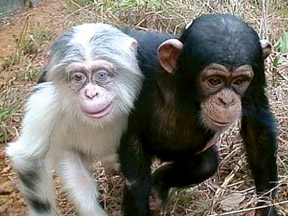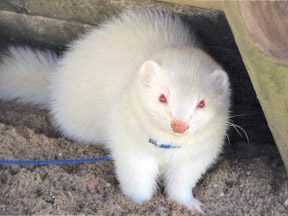Albino animals
In our April 7 issue, we said that we will give you more information
and pictures of other albino animals worldwide. Read the following
article and you will get some information about these animals.Albinism
is due to various gene mutations that affect the production of normal
pigmentation.
|

The cute little black and white duo |
|

Relaxing... |
True (amelanistic) albinos lack melanin and are white with no
markings and with unpigmented pink eyes. Partial (blue-eyed) albinos
have some residual pigmentation. There are various degrees of patchy
albinism (piebaldism) due to localised mutations in skin cells.
Temperature dependent albinos have residual colour on cooler parts of
the body i.e. Siamese cats where pigment develops on the head, tail and
legs, but not on the warmer parts of the body. Bluish-grey anerythristic
albinos lack the red colour. Axanthic albinos lack the yellow colour.
The actual colour and pattern of these animal depends on what other
colours are in the pattern. Tyrosinase-negative albinos lack tyrosinase
(an enzyme which synthesises melanin) in their cells; this usually
produces a pale yellowish or cream animal with pink-eyes. The more
common Tyrosinase Positive albino cannot synthesise melanin, but can
synthesise tyrosinase, giving a fawn or lavender (platinum) colour.
Leucism is often mistaken for albinism. Leucistic animals, such as white
lions, are white or very pale, with dark eyes and some pigmentation, for
example ghost markings. Chinchilla is sometimes mistaken for albinism,
but is caused by a different mutation that affects the distribution of
pigment on the hair shaft.
White tigers are chinchilla. Other mutations also cause white
animals; some of the animals pictured here (white peacocks) are white,
but not albino. Some of the photos of white, albino and pied animals on
this page are from the early 1930s encyclopaedias Wonders of Animal Life
(edited by J A Hammerton) and Wonderland of Knowledge (edited by Ernest
Ogan). Some of those specimens were photographed in captivity and are
now preserved in the Rothschild Zoological Museum.
Up until the late 19th century it was common practice for naturalists
and explorers to shoot and preserve unusual specimens. Not till the 20th
century did photography become a practical alternative. The majority of
the museum taxidermy specimens on these pages are from the Walter
Rothschild Zoological Museum, Tring, England and the Natural History
Museum, South Kensington, London, England.-
|

Looking for direction |

If stares can kill! |
- Internet
|


